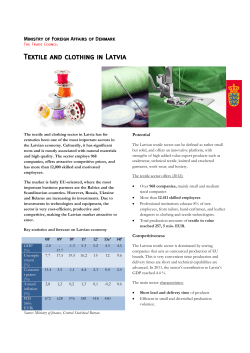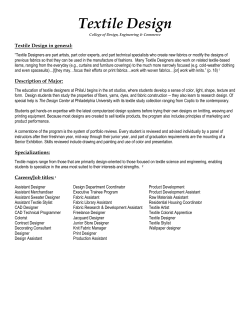
How to Dry Textile without Over-Drying. Abstract
How to Dry Textile without Over-Drying. Kaisa Bengtsson, Kathrine Segel, Henrietta Havsteen-Mikkelsen How to Dry Textile without Over-Drying. Kaisa Bengtsson, Kathrine Segel, Henrietta Havsteen-Mikkelsen Abstract The drying of a wet textile material requires an air stream to take away the water vapour from the surface. Adding heat speeds up drying. The following lecture on a very basic experiment confirms this claim. Introduction Hypothesis: Heat and ventilation are each essential to evaporate water from a surface. The purpose of this experiment is to investigate the drying mechanisms of textile. This will be done with the help of a heat- and/or air-source, building on the principle of the psychrometer. A psychrometer consists of two thermometers measuring the temperature of the air and a parallel wet cloth. When equilibrium is reached after a few minutes of air circulation the two temperatures are read and inserted to the psychrometric chart to decide, for example, the relative humidity. Psychrometric chart. Garry Thomson: The Museum Environment. Second Edition. Butterworth-Heinemann. 1986. p. 211. A wet material contains water molecules. Under normal conditions these molecules will start to evaporate into the air, if the relative humidity of the air is lower than 100%. The evaporation of water molecules will result in a temperature drop, because the energy used for evaporation is taken from the surrounding water molecules in the wet material. 1 How to Dry Textile without Over-Drying. Kaisa Bengtsson, Kathrine Segel, Henrietta Havsteen-Mikkelsen Therefore the evaporation rate is depending on two independent factors: 1: Heat. When adding heat the temperature of the surrounding air will raise and the relative humidity of the same air will drop. Therefore this air can now contain more water, which again speeds up the process of evaporation. 2: Air circulation. The air passing by the wet material will have a relative humidity of a 100% when leaving the material. By creating an air flow, “fresh” air (able to contain water) will be provided. This also speeds up the process of evaporation. Textile contains water corresponding to the relative humidity in the air. When the air temperature is 20oC and the relative humidity is 50%, a given piece of textile will contain around 9% of moisture in the fibres (capillaries). Therefore, when a piece of textile is dried it should be avoided that this moisture leaves the fibres, because this will lead to a deformation of the textile fibre. A wet piece of textile is surrounded by a layer of water molecules, but it also contains the above mentioned water molecules in the fibres, so called bound water. When drying a piece of textile, it is only the surrounding layer of water that should leave the textile fibre. Experimental principal The experiment is not looking at the fastest way of drying a textile – but possibly the safest. This will be done by looking at the effects of the two independent factors, heat and air circulation. Since the goal is to avoid over-drying of the textile the heat will be added under control and only to the ambient temperature. Therefore the added heat corresponds to the drop in temperature when the water is evaporating from the textile. To provide heat a hot plate is used. The textile is then placed on the plate. A fan is provided for creating air circulation. Experimental details A hot plate is covered by two (heat conducting) brass plates with an isolating layer in between. Before starting the experiments the heat-distribution on the brass plate was measured to insure that the temperature of the plate was even. The upper brass plate is covered by overlapping sheets of plain woven cotton cloth (see fig.1). In the middle area lies two identical pieces of cloth: one to be moveable for weighing, the other serves as a reference in which is sown 3 cm of a thermo coupler, and which is marked by a coloured thread at each end to facilitate measuring any change in dimension during the drying process (see fig.2). 2 How to Dry Textile without Over-Drying. Kaisa Bengtsson, Kathrine Segel, Henrietta Havsteen-Mikkelsen fig.1 fig.2 When weighing the piece of cloth this is removed from the hot plate with a tweezers to avoid exchange of moisture with the hand. Before weighing the cloth is slid into a plastic bag this is then sealed so that no water will evaporate into the air. During weighing, the fan (if used in the experiment) is turned off. The fan is in a distance of 2 meters and the ventilation is approximately put to 1m/s. Experiment 1: Drying on a hot plate with fan Experiment 2: Drying on a hot plate without fan Experiment 3: Drying on a cold plate with fan Equipment used: • • • • • • • • • • • • • Thermometer: Microprocessor Thermometer, Type J.K.T. Thermocouple, Model HH23 Omega. Weight: Mettler PJ400, <0.01> Hotplate: IKA-Combimag RCT 0-350ºC, diameter 13.5cm RH-measurement: TESTO 601 testoterm, %RF/RH/HR-ºC/ºF, Sekunden-hygrometer 601, measuring range 2.0-98.0%RF, -200-+800.0ºC, dew point. Fan: mrk. Alaska AD96M, 2 speeds, 50 W Two metal plates: Brass (22.5 x 25cm) Isolating material: Promatco (synthetic felt, chock absorbing material) Ruler: In centimetres Water Cotton cloth, plain woven, 13warp 11weft in dry stage. Cotton fibre verified by microscopy. Needle and thread Plastic bag with closing mechanism Tweezers 3 How to Dry Textile without Over-Drying. Kaisa Bengtsson, Kathrine Segel, Henrietta Havsteen-Mikkelsen Results 4 How to Dry Textile without Over-Drying. Kaisa Bengtsson, Kathrine Segel, Henrietta Havsteen-Mikkelsen Discussion Hypothesis: Heat and ventilation are each essential to evaporate water from a surface. The plotting of the three curves, based on weight (or % content of water) vs. time, shows the fastest drying result with heat (kept at room temperature) and fan on (approx. 40 min.). Second fast drying comes from the ventilator without heat (approx. 70 min.). Slowest rate is obtained with only keeping the heat at room temperature without blowing vapour away (approx. 120 min.). The three experiments had similar curves (fig.1). All three had a high evaporation rate in the beginning but after 5-10 minutes the speed slowed down and followed a linear slope - ending with a final deviation. The high evaporation rate in the beginning can be explained by some water drops left in the bag after first wet-weighing. If a straight line is drawn through the measured points from the three experiments in fig. 1, the three lines will all meet in the same point on the y-axis. This indicates in theory that the samples all had the same amount of water pr. square meter. In fig. 1 the bending of the curves can be explained by the samples containing more than 100% water from the beginning of the experiment. Using synthetic textile instead of natural fibres would possibly have resulted in a curve with a similar gradient, but without the final deviation. Errors: - Not the same amount of water in the samples, as the experiments started out. - Did not register the temperature in the two first experiments - The ventilation is not known accurate - Room not 100% controlled. Draft through windows and people coming in and out of door. 5 How to Dry Textile without Over-Drying. Kaisa Bengtsson, Kathrine Segel, Henrietta Havsteen-Mikkelsen - Hotplate is varying in temp. ± 1 - Drops of water are left in bag after first wet-weighing. - Temperature rises in textile when ventilation is turned off. - Textile is taken off hotplate for weighing – which exposes the textile to extra air circulation for a few seconds. The conclusion of the experiments is that the combination of controlled heat and ventilation has the strongest effect on drying the textiles without over-drying. The experiments also show that the effect of air is more important than controlled heat. Appendix Experiment 1 Room temp. : 20-20,5oC Weight (dry), bag + sample: 3,16g Distance to fan: 200cm vægt (g) 3,23 2,70 2,37 2,01 1,71 1,47 1,34 1,30 1,30 1,29 1,30 vand % 188,6 136,8 107,9 76,9 50,0 28,9 17,5 14,0 14,0 13,0 14,0 Relative humidity: 42-44% Measured lenght (dry): 112,0mm Weight, bag: 1,90g Weight (dry), sample: 1,26g tid (min) 0 5 11 19 24 28 34 39 44 48 54 mm 110,0 110,0 110,0 110,0 110,0 110,0 109,5 109,5 109,5 109,5 109,5 Experiment 2 Room temp.: 20,5oC Weight (dry), bag + sample: 3,16g vægt (g) 3,40 3,14 2,89 2,71 2,59 2,52 2,45 2,38 2,32 2,22 2,13 2,05 1,98 1,93 1,87 1,77 1,68 1,60 1,53 1,45 1,41 1,36 1,29 vand % 198,2 175,4 153,5 137,7 127,2 121,1 114,9 108,8 103,5 95,7 86,8 79,8 73,7 69,3 64,0 55,3 47,4 40,4 34,2 27,2 23,7 19,3 13,9 Relative humidity: 42% Measured lenght (dry): 111,0mm Weight, bag: 1,90g Weight (dry), sample: 1,26g tid (min) 0 5 10 16 21 25 30 35 40 45 50 55 60 65 70 75 80 85 90 95 100 105 125 mm 111,0 109,5 109,5 109,5 109,5 109,5 109,5 109,5 109,5 109,5 109,5 109,5 109,5 109,5 109,5 109,5 109,5 109,5 109,5 109,5 109,5 109,5 109,5 6 How to Dry Textile without Over-Drying. Kaisa Bengtsson, Kathrine Segel, Henrietta Havsteen-Mikkelsen Experiment 3 Room temp.: 20-21 oC Weight (dry), bag + sample: 3,15g Distance to fan: 200cm Relative humidity: 42% Measured lenght (dry): 100,0mm Weight, bag: 1,90g Weight (dry), sample: 1,25g vægt (g) vand % tid (min) mm 3,30 3,00 2,77 2,63 2,49 2,38 2,25 2,13 2,00 1,88 1,77 1,66 1,53 1,41 1,32 1,30 1,29 189,5 163,2 143,0 130,7 118,7 108,8 97,4 86,8 75,4 64,9 53,3 45,6 34,2 23,7 15,8 14,0 13,2 0 5 10 15 20 25 30 35 40 45 50 55 60 65 70 75 80 100,0 100,0 100,0 100,0 100,0 100,0 100,0 100,0 100,0 100,0 100,0 100,0 99,5 99,5 99,5 99,5 99,5 Temp (oC) 18,7 16,1 15,6 15,7 15,4 15,3 15,3 15,3 15,1 15,3 15,1 15,2 15,8 17,0 18,6 19,4 19,7 7
© Copyright 2025













